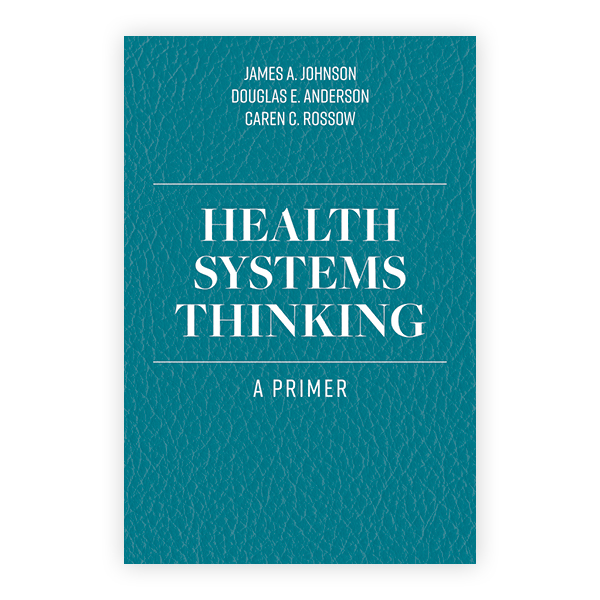Health care instructors serve as orchestrators of a systems approach mindset. They empower learners to see beyond patient symptoms and nurture an understanding of complex system relationships between patients, health care structures, and communities.
Health Systems Thinking: A Primer outlines its widespread acceptance across management, medicine, and social sciences, permeating both health care and public health domains. Beyond theoretical acceptance, this approach is increasingly embraced in clinical practice, public policies, and health education with influential bodies like the World Health Organization—creator of One Health—Centers for Disease Control and Prevention, American Medical Association, and National Institutes of Health advocating for its implementation.
Accrediting bodies in public health, health administration, and nursing have integrated systems thinking into core competencies, while health systems science finds its place in medical school curricula—a testament to its expanding influence. Read on to discover the essence of teaching systems thinking in nursing, exploring insights on integrating this approach into education, recognizing its intrinsic value, and embracing the manifold benefits it provides.
Helping Learners Understand Systems Thinking and Its Core Principles in Health Care
Bill Gates, founder of Microsoft and Co-President of the Bill and Melinda Gates Foundation, told Time Magazine in 2018, “Modernity is a miracle of systems. Jonas Salk was an amazing scientist, but he isn’t the only reason we’re on the doorstep of eradicating polio—it’s also thanks to the coordinated vaccination effort of health workers, NGOs, and governments. We miss the progress that’s happening right in front of us when we look for heroes instead of systems. If you want to improve something, look for ways to build better systems.”
Gates’ emphasis on the significance of systems over individual heroes echoes the essence of cultivating a systemic mindset among health care, and specifically nursing, professionals. This perspective underscores the pivotal role systems play in achieving holistic health care milestones, urging a shift toward understanding and enhancing systems thinking frameworks for more impactful change in the sector.
What is Systems Thinking in Health Care?
Systems thinking compels health leaders and clinicians to scrutinize the connections and interrelationships within a health system—aiming to identify sustainable solutions that deeply understand this structure. This involves methodically analyzing the underlying causes of issues and inefficiencies. Moreover, it revolves around nonlinear assumptions about human behavior and feedback loops, enabling the assessment of a system's behavior evolution. This pinpoints pivotal junctures to create more reliable and innovative health systems capable of meeting set objectives. Today, the principles and tools of systems thinking suit a myriad of health settings and professions, organizational cultures, and policy challenges.
A Frontiers in Public Health report reveals that 75% of health care industry stakeholders have employed systems thinking, while 12.5% are uncertain and another 12.5% haven't utilized this methodology previously. This highlights the growing acceptance and adoption of systems thinking within the health care industry while indicating a need for further education or exposure. Moreover, the variance in adoption rates underscores that some stakeholders may require more guidance or evidence of its effectiveness before fully embracing this methodology.
5 Ways to Integrate Systems Thinking into Health Care Curricula
As educators incorporate systems thinking into health care curricula for students, future caregivers grasp the intricate relationships within diverse health systems more effectively. The aim is to equip learners with a holistic understanding that goes beyond individual patient care, enabling them to navigate complex health care environments more effectively. Instructors can promote a holistic approach to patient care and health problems with the following strategies:
1. Utilizing real-world case studies
Incorporate real-world case studies in health care curricula to expose students to the interconnected facets of health care systems. Practical examples vividly demonstrate how various components within the system interact, emphasizing the ripple effects of their decisions and actions in the field. By immersing learners in life-like scenarios, instructors foster a profound understanding of how health care elements interrelate and impact health outcomes.
To effectively introduce this strategy, curate diverse case studies that reflect multifaceted health care settings and scenarios. Encourage students to analyze these cases collaboratively and discuss the interdependencies between health care components to broaden their perspective. Moreover, consider debriefing sessions afterward to fully explore the complexities of system dynamics—promoting necessary critical thinking and problem-solving skills.
2. Implementing interactive simulations
Hands-on simulations replicating complex health care systems allow students to actively engage in more experiential learning. These exercises essentially emulate real-world health care scenarios, enabling learners to witness firsthand the intricate interplay between a myriad of components within a health system. Offering a more dynamic learning environment that immerses learners in simulated settings helps foster a deeper understanding of system dynamics, decision-making processes, and the impact of interventions.
Leverage this approach by designing scenarios that mimic diverse health care environments and encouraging your classes to collaborate and navigate through each situation. Similar to case studies, post-simulation reviews are crucial for students to reflect on their experiences, identify connections between system components, and apply critical thinking to problem-solving within nursing and health care.
3. Fostering cross-disciplinary collaboration
Encourage and introduce opportunities for cross-disciplinary collaboration—such as integrating sociology, economics, or environmental science into health care curricula—to broaden nursing students' perspectives. Exploring diverse fields quickly unveils the interconnectedness between health care and diverse societal, economic, or environmental factors. Equipped with a comprehensive understanding of health care complexities beyond clinical aspects, future nursing professionals are better prepared to navigate multifaceted health care systems.
Consider inviting guest speakers from various disciplines to discuss their field's impact on health care, or vice versa. This might include interdisciplinary projects or case studies to engage students in analyzing health care challenges from unique viewpoints. Discussion forums where learners can exchange ideas across disciplines also promote a more holistic approach to health care problem-solving.
4. Conducting workshops on systems mapping
Host seminars on systems mapping for nursing students, so learners have a visual representation of the interconnected relationships and feedback loops within health care systems. This equips learners with a clear understanding of systems thinking methods, aiding in improved patient care and navigation of complex health care environments.
By explaining the fundamentals of systems mapping, instructors highlight its significance in grasping the dynamics of public health systems. Plus, engaging students in hands-on activities where they create visual representations of interconnected components facilitates active learning. Educators may also incorporate real-life scenarios or related case studies to allow students the opportunity to apply systems mapping techniques practically.
5. Emphasizing problem-solving through a systems lens
Encourage problem-solving from a systems perspective to prompt nursing students to consider the wider ramifications of their decisions. This is an effective approach to nurture critical thinking beyond individual patient care and prepare students to address multifaceted challenges within health care environments.
To encourage thinking through a systems lens, pose case studies or scenarios that necessitate learners to analyze issues holistically. This can include discussions to explore the interconnectedness of elements within each application within the health care system and consider the broader system impacts. Educators not only reinforce systems thinking but also equip future nurses to address complex health care issues with more comprehensive solutions.
How Instructors Overcome Challenges in Teaching Systems Thinking
As health care educators acknowledge the importance of integrating systems thinking into teaching, they run into several common challenges. The obstacles that emerge while nurturing a holistic mindset among students include:
- Overcoming reductionist thinking: Students may initially approach patient care from a narrow viewpoint, focusing solely on symptoms to promote their well-being and recovery. To get learners out of this mindset, utilize case studies that emphasize the interconnected nature of health care and encourage students to continuously explore multifaceted scenarios beyond singular perspectives.
- Complexity and information overload: Because of the inherently holistic nature of systems thinking, there is potential for complexity and information overload as students analyze intricate systems. Employ gradual exposure and break down complex concepts into more digestible pieces to facilitate step-by-step comprehension.
- A lack of real-world examples: Tangible examples are a linchpin in ensuring students understand the full scope and impact of systems thinking in health care. Utilizing educational resources that offer diverse, relatable case studies, simulations, or interactive exercises is imperative to bridge the gap between theory and real-world application for learners.
- Resistance to change: Opposition to improvements within well-established educational paradigms may impede the adoption of new teaching methodologies. To overcome this, take care to foster an inclusive, future-thinking environment and showcase the relevance and benefits of systems thinking.
What Are the Key Benefits of an Improved Systems Thinking Education?
By championing systems thinking in teaching, educators forge a path where nursing students feel confident navigating complex health care scenarios. Integrating this approach into curricula enriches learners with a deeper understanding of holistic thinking methods, leading to key benefits such as:
- Refined problem-solving skills: By engaging with interconnected health care systems, learners practice unraveling complexities strategically and identifying root causes of health care issues beyond surface-level reasons. This encourages every nursing student to become a systems thinker throughout their education and well into their professional careers.
- Enhanced decision-making capabilities: Teaching students to embrace a broader perspective honed their skills in assessing multifaceted situations and crafting informed, impactful choices in patient care and system improvements.
- Increased adaptability: Resilience becomes inherent as learners grasp the fluid dynamics within health care settings. This ensures future professionals can pivot seamlessly amid evolving scenarios and changing patient needs.
- Reduced errors: Preparing students to anticipate potential pitfalls within intricate health care systems ensures they can mitigate risks, boost safety, and enhance care delivery. According to research published in the National Library of Medicine, systems thinking is positively associated with safety culture and fewer medication errors.
- Improved patient outcomes: Armed with holistic thinking methods, nursing students can deliver more comprehensive care—addressing not only symptoms but the full and intricate web of factors impacting patient health.
Considering Future Trends and Innovations in Systems Thinking for Health Care
The landscape of health care is evolving—and quickly. As a result, educators must align instructional strategies with emerging trends and technologies to fortify systems thinking in nursing. Here are some significant technological trends worth noting:
- Data analytics: empowering students to decipher complex patterns and correlations within health care systems.
- Artificial intelligence: processing intricate data sets, facilitating predictive modeling and scenario analysis, and enabling students to anticipate system behaviors and outcomes.
- Practical simulations: offering immersive learning experiences that allow learners to navigate dynamic health care scenarios and apply systems thinking principles in real-time.
As these technologies and trends converge, educators can equip learners with a powerful toolkit to cultivate a deeper understanding of interconnected health care systems. Embracing these innovations not only enriches systems thinking education but also equips future nurses with the agility and insight needed to navigate the complex and ever-evolving landscape of health care delivery.

